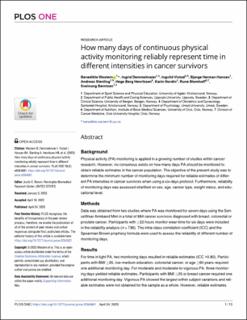| dc.description.abstract | Background
Physical activity (PA) monitoring is applied in a growing number of studies within cancer research. However, no consensus exists on how many days PA should be monitored to obtain reliable estimates in the cancer population. The objective of the present study was to determine the minimum number of monitoring days required for reliable estimates of different PA intensities in cancer survivors when using a six-days protocol. Furthermore, reliability of monitoring days was assessed stratified on sex, age, cancer type, weight status, and educational level.
Methods
Data was obtained from two studies where PA was monitored for seven days using the SenseWear Armband Mini in a total of 984 cancer survivors diagnosed with breast, colorectal or prostate cancer. Participants with ≥22 hours monitor wear-time for six days were included in the reliability analysis (n = 736). The intra-class correlation coefficient (ICC) and the Spearman Brown prophecy formula were used to assess the reliability of different number of monitoring days.
Results
For time in light PA, two monitoring days resulted in reliable estimates (ICC >0.80). Participants with BMI ≥25, low-medium education, colorectal cancer, or age ≥60 years required one additional monitoring day. For moderate and moderate-to-vigorous PA, three monitoring days yielded reliable estimates. Participants with BMI ≥25 or breast cancer required one additional monitoring day. Vigorous PA showed the largest within subject variations and reliable estimates were not obtained for the sample as a whole. However, reliable estimates were obtained for breast cancer survivors (4 days), females, BMI ≥30, and age <60 years (6 days).
Conclusion
Shorter monitoring periods may provide reliable estimates of PA levels in cancer survivors when monitored continuously with a wearable device. This could potentially lower the participant burden and allow for less exclusion of participants not adhering to longer protocols. | en_US |

